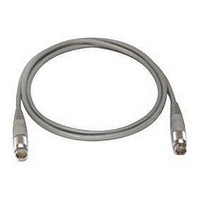11730D AGILENT TECHNOLOGIES, 11730D Datasheet - Page 17

11730D
Manufacturer Part Number
11730D
Description
SENSOR CABLE, 50FT
Manufacturer
AGILENT TECHNOLOGIES
Datasheet
1.11730D.pdf
(234 pages)
Specifications of 11730D
Leaded Process Compatible
No
Peak Reflow Compatible (260 C)
No
Cable Length
50ft
Features
Reduces RFI Effect On Low Power Readings With Improved Shielding Design
Cable Assembly Type
Sensor
Cable Color
Gray
Rohs Compliant
No
For Use With
8480 & E-Series Power Sensors
Lead Free Status / RoHS Status
Contains lead / RoHS non-compliant
- Current page: 17 of 234
- Download datasheet (7Mb)
6
3
Adapters and Connectors
General Connector Information
Overview
Many coaxial connector types are available
in the RF and microwave industry, each
designed for a specific purpose and
application. For measurement
applications, it is important to consider the
number of connects/disconnects, which
impact the connector’s useful life.
The frequency range of any connector is
limited by the excitation of the first circular
waveguide propagation mode in the
coaxial structure. Decreasing the diameter
of the outer conductor increases the
highest usable frequency; filling the air
space with dielectric lowers the highest
usable frequency and increases
system loss.
Performance of all connectors is affected
by the quality of the interface for the
mated pair. If the diameters of the inner
and outer conductors vary from the
nominal design, if plating quality is poor,
or if contact separation at the junction is
excessive, then the reflection coefficient
and resistive loss at the interface will
be degraded.
A few connectors, such as the APC-7, are
designed to be sexless. Most are female
connectors that have slotted fingers, which
introduce a small inductance at the
interface. The fingers accommodate
tolerance variations but reduce
repeatability and may ultimately break after
1000 connections. Agilent offers slotless
versions of connectors in certain measuring
products, which decrease inductance and
increase repeatability.
The following is a brief review of common
connectors used in test and measurement
applications:
APC-7 (7 mm) connector
The APC-7 (Amphenol Precision
Connector-7 mm) offers the lowest
reflection coefficient and most repeatable
measurement of all 18 GHz connectors.
Development of the connector was a joint
effort between HP and Amphenol, which
began in the 1960s. This is a sexless
design and is the preferred connector for
the most demanding applications, notably
metrology and calibration.
Type-N connector
The type-N (Navy) 50 Ω connector was
designed in the 1940s for military systems
operating below 4 GHz. In the 1960s,
improvements pushed performance to
12 GHz and later, mode-free, to 18 GHz.
Agilent offers some products with slotless
type-N center conductors for improved
performance to 18 GHz. Agilent type-N
connectors are completely compatible with
MIL-C-39012. Certain 75 Ω products use a
type-N design with smaller center
conductor diameters, and thus are not
compatible with 50 Ω connectors.
SMA connector
The SMA (Subminiature A) connector was
designed by Bendix Scintilla Corporation
and is one of the most commonly used
RF/microwave connectors. It is intended
for use on semirigid cables and in
components that are connected
infrequently. Most SMA connectors have
higher reflection coefficients than other
connectors available for use to 24 GHz
because of the difficulty to anchor the
dielectric support.
3.5 mm connector
The 3.5 mm connector was primarily
developed at Hewlett Packard – now
Agilent Technologies, with early
manufacturing at Amphenol. Its design
strategy focused on highly-rugged physical
interfaces that would mate with popular
SMA dimensions, allowing thousands of
repeatable connections. It is mode-free to
34 GHz.
1.0 mm launch
The launch adapter has a 1.0 mm female
connector on one end and a glass to metal
seal interface on the other end. This is for
transition of ultra-high frequency (up to
110 GHz) signals from coax into a
microstrip package or onto a circuit board.
Related parts for 11730D
Image
Part Number
Description
Manufacturer
Datasheet
Request
R

Part Number:
Description:
Agilent Tachyon DX4+ (HPFC-5700) Dual-Channel 4-Gb Fibre Channel Controller With The Data Integrity Field (DIF) Feature
Manufacturer:
Agilent Technologies, Inc.

Part Number:
Description:
Manufacturer:
Agilent Technologies, Inc.
Datasheet:

Part Number:
Description:
Manufacturer:
Agilent Technologies, Inc.
Datasheet:

Part Number:
Description:
Manufacturer:
Agilent Technologies, Inc.
Datasheet:

Part Number:
Description:
Manufacturer:
Agilent Technologies, Inc.
Datasheet:

Part Number:
Description:
Manufacturer:
Agilent Technologies, Inc.
Datasheet:

Part Number:
Description:
Manufacturer:
Agilent Technologies, Inc.
Datasheet:

Part Number:
Description:
Manufacturer:
Agilent Technologies, Inc.
Datasheet:

Part Number:
Description:
Manufacturer:
Agilent Technologies, Inc.
Datasheet:

Part Number:
Description:
Manufacturer:
Agilent Technologies, Inc.
Datasheet:

Part Number:
Description:
Manufacturer:
Agilent Technologies, Inc.
Datasheet:

Part Number:
Description:
Manufacturer:
Agilent Technologies, Inc.
Datasheet:

Part Number:
Description:
1.0625 GBd Fibre Channel 10x10 mm QFP Transceiver Chip (Recommend HDMP-1636A for new designs)
Manufacturer:
Agilent Technologies, Inc.
Datasheet:

Part Number:
Description:
Manufacturer:
Agilent Technologies, Inc.
Datasheet:

Part Number:
Description:
1.0625-2.125 GBd Serdes Circuits: SSTL_2
Manufacturer:
Agilent Technologies, Inc.
Datasheet:










